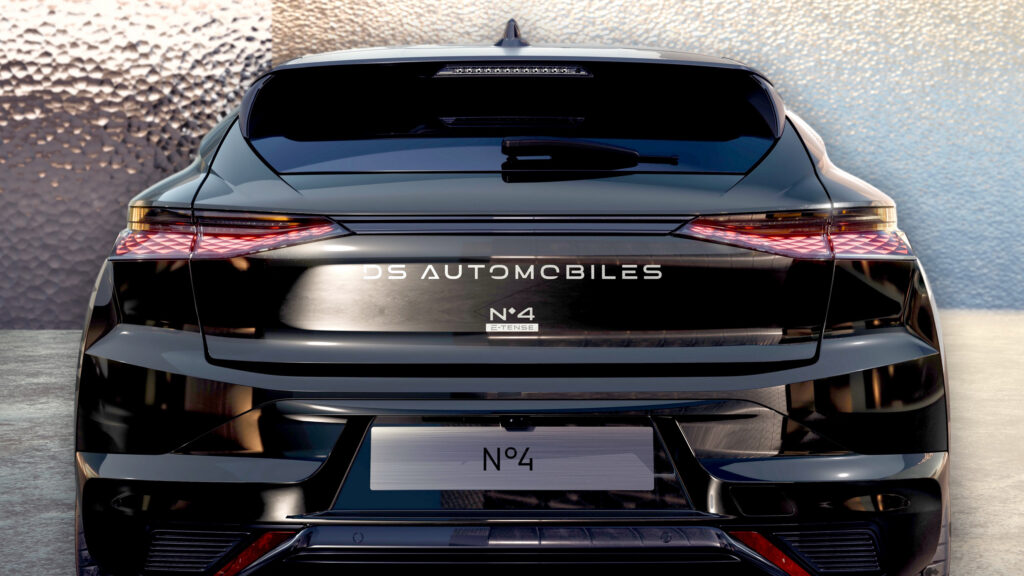The Most Chic Hatch From Stellantis Just Got a New Identity


- DS has introduced the new N°4, which replaces the current DS4.
- The model features revised styling and an updated interior.
- Customers can get electric, plug-in hybrid, and hybrid powertrains.
DS Automobiles has revealed the N°4, essentially a rebranded and refreshed version of the DS4. Drawing inspiration from the brand’s flagship N°8, the new model marks a pretty notable departure from its predecessor, with design updates that give it a more premium feel while retaining a familiar aesthetic.
var adpushup = window.adpushup = window.adpushup || {que:[]};
adpushup.que.push(function() {
if (adpushup.config.platform !== “DESKTOP”){
adpushup.triggerAd(“0f7e3106-c4d6-4db4-8135-c508879a76f8”);
} else {
adpushup.triggerAd(“82503191-e1d1-435a-874f-9c78a2a54a2f”);
}
});
Starting up front, the premium hatchback adopts an all-new front fascia with a slender grille that lights up. It’s joined by an illuminated DS logo as well as revised daytime running lights. Designers also added a more expressive bumper with a visually expanded lower intake. Elsewhere, the hood has been extended by 0.5 inches (12 mm) to cover part of the grille.
More: Stellantis’ Presidential Ride Is A French Flag On Wheels
Moving further back, we can see a familiar profile and 19- or 20-inch wheels. They’re joined by a ‘floating’ roof, which can be had in a contrasting black color. The subtle changes continue out back with dark accents and new badging.
A Familiar, But Improved Cabin
While the exterior sports some notable changes, the cabin is instantly recognizable. However, there’s a larger 10.25-inch digital instrument cluster and a 10-inch infotainment system.
The company didn’t have much else to say about the interior, but higher-end variants offer Alcantara and Criollo Brown Nappa leather as well as brown ash wood trim. Customers can also get heated front seats, a wireless smartphone charger, and a 14 speaker Focal audio system.
In terms of space, the Hybrid can hold 15.2 cubic feet (430 liters) of luggage while the Plug-In Hybrid comes up short at 12.7 cubic feet (360 liters). The EV effectively splits the difference at 13.8 cubic feet (390 liters).
var adpushup = window.adpushup = window.adpushup || {que:[]};
adpushup.que.push(function() {
if (adpushup.config.platform !== “DESKTOP”){
adpushup.triggerAd(“bb7964e9-07de-4b06-a83e-ead35079d53c”);
} else {
adpushup.triggerAd(“9b1169d9-7a89-4971-a77f-1397f7588751”);
}
});
A Powertrain For Everyone
The fully electric N°4 E-Tense features a 58.3 kWh battery pack and an electric motor developing 210 hp (157 kW / 213 PS) and 253 lb-ft (343 Nm) of torque. This gives the car a WLTP combined range of 280 miles (450 km). When the battery is low, a 120 kW DC fast charger can take it from 20% to 80% in around 30 minutes.
The N°4 Plug-In Hybrid has a turbocharged four-cylinder petrol engine and an electric motor that has been integrated into a new seven-speed dual-clutch transmission. They’re joined by a new 14.6 kWh battery, which increases the electric-only range by 30%.
Jumping into the numbers, the PHEV has a combined output of 222 hp (165 kW / 225 PS) and 265 lb-ft (360 Nm) of torque. This enables the model to accelerate from 0-62 mph (0-100 km/h) in 7.1 seconds, which is 0.3 seconds faster than its predecessor. Besides being faster, the hatch has an electric-only combined range of up to 50 miles (81 km).
var adpushup = window.adpushup = window.adpushup || {que:[]};
adpushup.que.push(function() {
if (adpushup.config.platform !== “DESKTOP”){
adpushup.triggerAd(“b25ecba7-3bbb-4ea7-a3a8-dbea91695c07”);
} else {
adpushup.triggerAd(“e46c436a-adeb-4b5e-a2c7-56bc36561c10”);
}
});
Customers looking for a more traditional experience can opt for the N°4 Hybrid. It features a turbocharged 1.2-liter three-cylinder petrol engine and a six-speed dual-clutch transmission with an integrated electric motor. This means the model has 143 hp (107 kW / 145 PS) and 170 lb-ft (230 Nm) of torque. DS also said drivers can expect to travel in “all-electric [mode] for up to 50% of the time during urban use, depending on traffic conditions and driving style.”